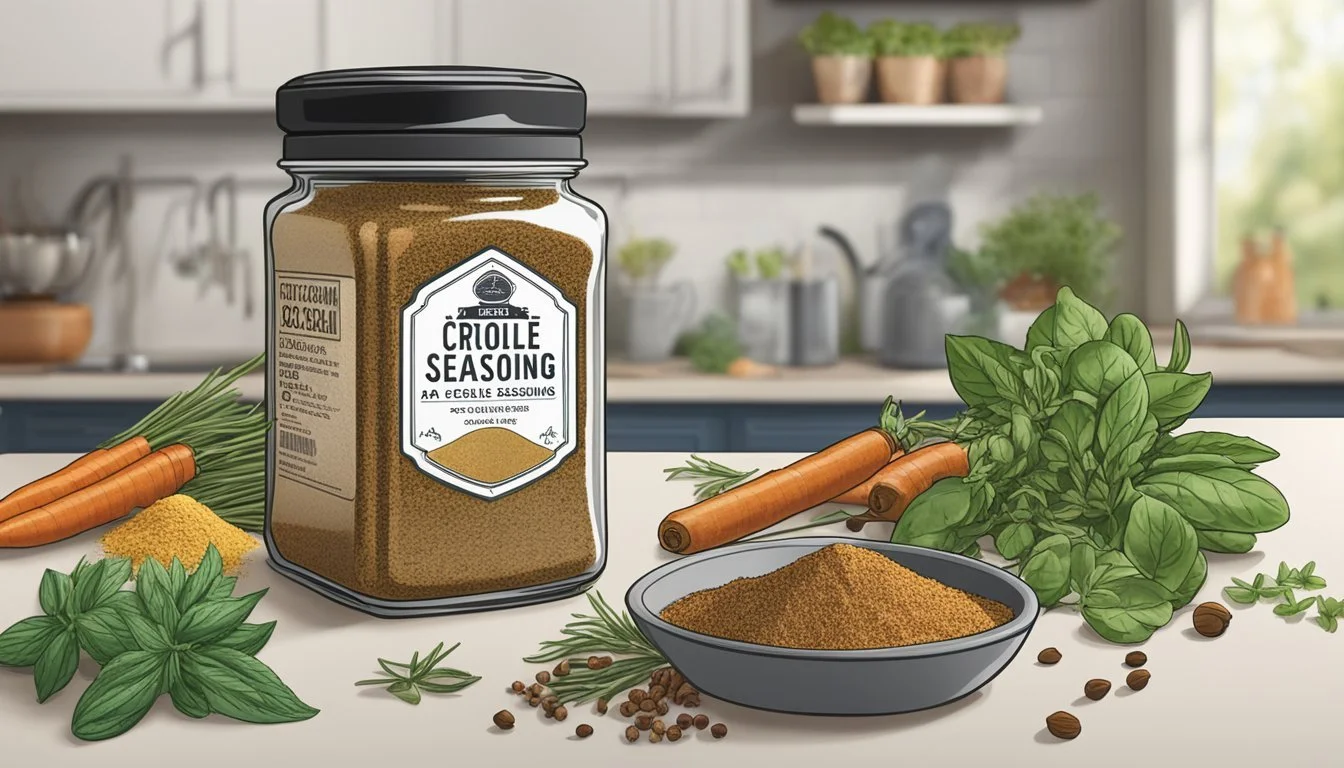Does Creole Seasoning Expire?
Shelf Life and Storage Tips
Creole seasoning, a blend of various herbs and spices, is a staple in many kitchens for its ability to enhance the flavors of meats, seafood, and stews. Stored properly, Creole seasoning can maintain its quality and potency for about two to three years. To ensure maximum shelf life, it’s crucial to keep the seasoning in airtight containers and avoid exposing it to moisture and heat.
The quality of the herbs and spices used in Creole seasoning can also affect its longevity. High-quality, fresh ingredients will result in a seasoning that not only lasts longer but also remains more flavorful throughout its use. Using wet utensils to scoop out the seasoning can introduce moisture, leading to clumping and a faster rate of spoilage.
For those who enjoy the robust and savory flavors of Creole dishes, understanding how to store and handle Creole seasoning will help maintain its effectiveness and ensure that it remains a key component in your culinary toolkit. High-quality storage practices are essential in preserving the rich flavors that Creole seasoning brings to the table.
Understanding Creole Seasoning
Creole seasoning is a distinctive blend used in Creole cuisine, particularly popular in New Orleans and Louisiana. It combines a variety of spices to create a rich and aromatic flavor profile.
Common ingredients in Creole seasoning include paprika, garlic powder, onion powder, thyme, oregano, basil, black pepper, white pepper, and cayenne pepper. These spices are mixed in specific proportions to achieve a balanced taste.
Key Differences: Creole vs. Cajun Seasoning
Both Creole and Cajun seasonings are staples in Louisiana cooking but have distinct differences. While Creole seasoning focuses more on herbs, such as oregano and thyme, Cajun seasoning typically emphasizes the heat from cayenne pepper.
Feature Creole Seasoning Cajun Seasoning Main Ingredients Paprika, garlic, onion, herbs Cayenne pepper, garlic, paprika Flavor Profile Savory and aromatic Spicy and bold Culinary Use Varied dishes, including stews Primarily meat and seafood
Creole seasoning simplifies cooking by providing a pre-mixed blend that eliminates the need to measure out individual spices each time. This is particularly useful in busy kitchens where time is of the essence.
Culinary Applications
This seasoning is versatile and used in:
Gumbos
Jambalayas
Etouffees
Grilled meats and vegetables
Creole seasoning allows cooks to infuse traditional New Orleans flavor into many dishes, making it a beloved spice blend in many households.
Composition of Creole Seasoning
Creole seasoning comprises various ingredients that form its unique taste profile. These elements fall into two main categories: primary ingredients and herbs and spices.
Primary Ingredients
The foundation of Creole seasoning typically includes salt, black pepper, paprika, and cayenne pepper.
Salt: Acts as a flavor enhancer.
Black pepper: Adds pungency.
Paprika: Contributes a mild sweetness and vibrant color.
Cayenne pepper: Provides heat and a spicy kick.
Each component plays a crucial role in building the base flavors. The proportions may vary, but these primary ingredients are essential for authentic Creole dishes.
Herbs and Spices
Various herbs and spices are added to create a complex and aromatic blend. Common choices include:
Garlic powder: Imparts a savory depth.
Onion powder: Adds a mild, sweet pungency.
Other dried herbs that enrich the seasoning are:
Dried thyme: Offers earthy and minty notes.
Dried oregano: Brings a hint of bitterness and robustness.
Dried basil: Adds a subtle sweetness.
These herbs ensure that Creole seasoning is both flavorful and aromatic. Each herb and spice is chosen for its unique impact on taste and aroma, creating a well-rounded seasoning ideal for various dishes.
Shelf Life and Indicators of Freshness
Creole seasoning can maintain its flavor and potency for varied lengths of time depending on several factors. Proper storage is key to preserving its quality, including keeping it in a cool, dark place.
Signs of Expiry
Creole seasoning typically lasts up to a year under optimal storage conditions. However, it can start losing its potency after six months.
Indicators of expired seasoning include:
Dull color: Fresh Creole seasoning usually has vibrant hues.
Faded aroma: A significant drop in its trademark aromatic profile suggests a loss of potency.
Caking or clumping: If moisture seeps in, the seasoning can clump together, indicating spoilage.
If the seasoning lacks its original flavor or aroma, it's time to replace it.
Maximizing Potency
To ensure Creole seasoning stays fresh for as long as possible, store it in an airtight container. The container should be kept in a cool, dry, and dark place to prevent exposure to heat and humidity, which can accelerate spoilage.
Best practices for storage:
Airtight container: Prevents air and moisture from entering.
Cool and dark place: Reduces the risk of heat and light diminishing its quality.
Avoid storing seasoning near stovetops or windows where temperature fluctuations are common, as these can further degrade its quality and potency. Properly maintained, Creole seasoning can be flavorful for up to a year.
Proper Storage Techniques
Storing Creole seasoning correctly ensures it retains its flavor and potency for a longer period. Essential tips include keeping it away from moisture and light and using appropriate containers.
Recommendations for Extending Shelf Life
Use airtight containers with tight-fitting lids to prevent moisture and air from entering. This helps maintain the seasoning's quality.
Store the containers in a dark cupboard or pantry to protect from sunlight, which can degrade the spices quickly.
Check the seasoning's aroma and appearance regularly to ensure it has not lost its potency. Proper storage can keep your Creole seasoning tasting fresh and flavorful for months or even years.
Culinary Uses of Creole Seasoning
Creole seasoning enhances a variety of dishes with its rich blend of spices. It's an essential ingredient in traditional Creole dishes and offers versatile applications in everyday cooking.
Traditional Creole Dishes
Creole seasoning is integral to many traditional dishes such as jambalaya and gumbo. It provides the needed depth and complexity to these hearty stews. For jambalaya, it complements the mix of meat, seafood, and rice, creating a harmonious and flavorful dish.
In gumbo, it's used to season the crawfish, chicken, and sausage, infusing the dish with a savory and slightly spicy taste. This seasoning is also key in crawfish boil, where it enriches the flavor of the seafood.
Another staple is etouffee, a thick stew of shellfish or chicken, where the seasoning ensures a robust and aromatic dish. It is also used in red beans and rice, amplifying the earthy flavors of the beans and providing a zesty kick.
Versatile Applications in Cooking
Beyond traditional dishes, Creole seasoning is versatile in other cooking applications. It works well as a dry rub for grilling and roasting meat and fish. It imparts a distinctive flavor to chicken, bringing out the savory notes of the herbs and spices.
For breakfast, it's excellent for seasoning eggs, adding a spicy edge to omelets or scrambled eggs. It enhances soups and stews, providing a well-rounded, intricate flavor profile.
Creole seasoning is also used in marinades for seafood, ensuring the fish or shrimp absorb the aromatic blend. As a general seasoning blend, it's perfect for daily cooking, whether sprinkling over vegetables or infusing rice and pasta dishes with an added layer of flavor.
Creating Your Own Creole Seasoning Blend
Creating a homemade Creole seasoning blend ensures the freshest spices and allows customization to suit personal tastes. The base recipe includes staple ingredients, and further adjustments can be made to enhance flavor profiles.
Homemade Blend Recipe
A traditional Creole seasoning blend typically starts with a base of salt, garlic powder, and onion powder. Followed by a mix of cayenne pepper, paprika, and black pepper for spice. Lastly, herbs like basil, thyme, and oregano complete the mix.
Here's a basic recipe:
2 tablespoons of paprika
1 teaspoon of cayenne pepper
1 tablespoon of garlic powder
1 tablespoon of onion powder
1 teaspoon of black pepper
1 teaspoon of dried oregano
1 teaspoon of dried thyme
1 teaspoon of dried basil
Combine all ingredients in a bowl and mix well. Store the seasoning in an airtight container for up to six months for optimal freshness.
Adjustments for Personal Taste
To cater to individual preferences, varying spice levels and flavors can tailor the blend. For those who prefer a spicier mix, increasing cayenne pepper or adding red pepper flakes can intensify the heat.
For a smokier flavor, substitute regular paprika with smoked paprika. A low-sodium version can be achieved by omitting the salt entirely. Ensuring herb freshness by using recently dried thyme, oregano, and basil can enhance the overall flavor profile.
Adjustments:
Increase cayenne for extra heat
Use smoked paprika for a rich, roasted taste
Omit salt for a low-sodium option
Ensure herbs are freshly dried
Creating a personalized blend not only achieves preferred taste profiles but also guarantees the freshness of the homemade seasoning.
Comparing Creole and Cajun Seasonings
Creole and Cajun seasonings are essential spice blends in Southern cuisine, though they differ in flavor profiles and culinary applications. Their unique blends of spices and herbs bring distinct tastes to various dishes.
Flavor Profiles and Ingredients
Cajun seasoning is known for its bold, spicy kick. The heat primarily comes from cayenne pepper and black pepper. It often includes paprika, garlic powder, and onion powder, providing a strong and savory flavor. Some variations also incorporate white pepper and dried chili flakes to increase the heat.
Creole seasoning, on the other hand, has a milder and more herbaceous flavor profile. It includes a variety of herbs such as oregano, thyme, and sometimes marjoram. Additionally, it uses black, white, and cayenne peppers. The combined spices produce a more complex and nuanced taste, often considered more refined than Cajun seasoning.
Application in Recipes
Cajun seasoning excels in dishes that require a robust and fiery flavor. It is frequently used in roasted meats, grilled fish, and hearty stews. Its boldness can enhance the taste of dishes like jambalaya, gumbo, and blackened fish, adding a significant kick of heat.
Creole seasoning's versatility stems from its herb-forward profile. It’s ideal for flavoring soups, sauces, and even eggs. The blend's more nuanced flavor allows it to complement seafood dishes, rice, and vegetables without overpowering them. Its subtle complexity makes it a great addition to creamy dishes as well.
By understanding these distinctions, cooks can choose the appropriate seasoning to enhance their culinary creations.
Cultural and Historical Significance
Creole seasoning holds a distinct place in culinary history. Originating from Louisiana, USA, it represents a unique fusion of various cultures. Influences from French, Spanish, African, and Caribbean traditions create a blend that is both bold and vibrant.
The French contributed techniques and flavors, while African elements added depth and spice. This mix embodies a rich cultural tapestry, making Creole seasoning an essential part of the region's cuisine.
Creole cuisine often employs herby and spiced blends, making it suitable for dishes such as marinades, grilled, and smoked meats. Unlike Old Bay seasoning, which originated in Maryland, Creole seasoning is more versatile in its applications.
Though similar in certain aspects, Creole seasoning stands out in its use of fresh, high-quality ingredients. This approach results in a more refined and complex flavor profile. It's not just a seasoning but a reflection of the diverse cultures that influenced its creation.
Whether used in a marinade for grilled fish or as a seasoning for hearty stews, Creole seasoning showcases the harmonious blend of different cultures. It is a testament to the region's vibrant culinary heritage.









